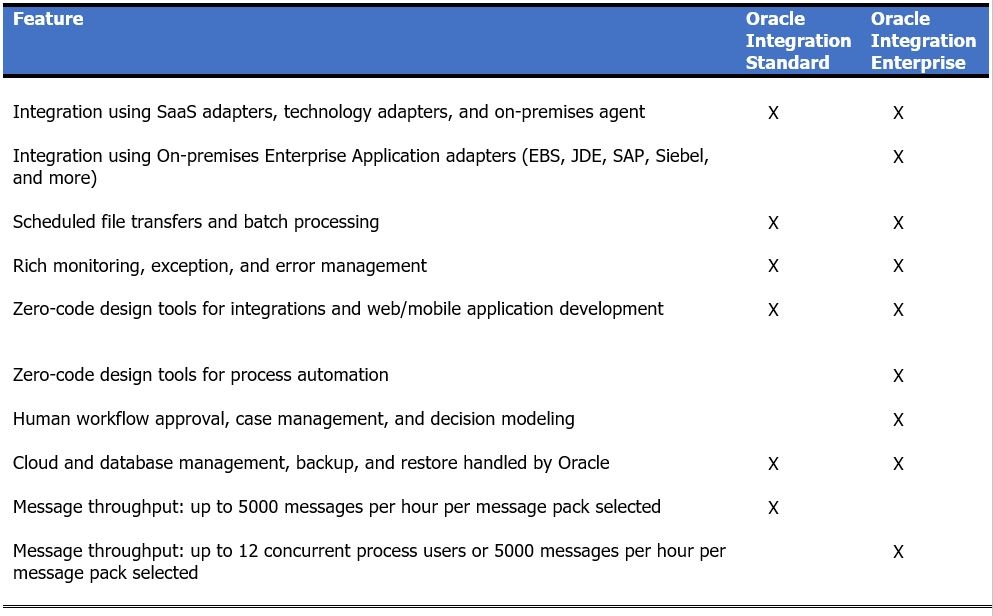This blog post was kindly researched and written by:
Mihaela Cornea of The University of North Carolina at Chapel Hill
James Imgraben of University of South Australia
While a lot of this information is taken directly from Oracle, it can be hard to find a holistic overview of Oracle Integration Cloud detailing what each version provides as well as emphasizing the main differences between Oracle Integration Classic (OIC-C) and Oracle Integration Cloud (OIC). This blog hopes to bring this information together to make it easier to understand.
First off, Oracle introduced new names for the Oracle Integration Cloud Products. Oracle Integration (OIC-C) formerly known as Oracle Integration Cloud will be seen on your Cloud Dashboard as “Oracle Integration Classic” while Oracle Integration (OIC) formerly known as Autonomous Oracle Integration Cloud will be seen as “Oracle Integration.” Note that this change has no impact on functionality.
Both OIC-C and OIC have a Standard and Enterprise versions. Each version gives the power to integrate your Institution Software as a Service (SaaS) applications and your on-premise applications. Enterprise version enables you to also design, automate, and manage your business processes in the cloud. Oracle handles cloud and database management, backup, restore, and other administrative tasks regardless of each of the two versions your institution choose.

Whether it is OIC-C or OIC the integration engine is essentially the same as for the Integration Cloud Service (ICS) which was the original product. Oracle Integration Cloud brings together a number of different existing PaaS solutions into a single offering: Integration Clod Service (ICS), Process Cloud Service (PCS), and Visual Application Builder Service (VBCS) to support PCS, Insight and Streams. While ICS was packaged and only available as a single Cloud Integration product licensed on the number of connections, the OIC-C and OIC were packaged as a suite and allow users to have access to the underlying infrastructure components. Oracle application expertise was leveraged to build an extensive library of adapters to Oracle and 3rd party SaaS and on-premises applications that enables institutions to deliver new business services much faster.
The main difference between OIC-C and OIC is that OIC-C is managed by the Customer while OIC is Oracle Managed. On an OIC-C instance, an administrator is responsible for maintaining the infrastructure on which OIC is built, can apply a patch, initiate on-demand backups, schedule automated backups, add or remove nodes for increased or reduced load.
Please refer to the links below for more info/highlights on user managed tasks:
https://docs.oracle.com/en/cloud/paas/integration-cloud/user-managed.html
https://docs.oracle.com/en/cloud/paas/integration-cloud/integration-cloud-auton/administer-oracle-integration-classic-user-managed.html
In OIC your organization service instance, including performing backups, upgrades, patching, scaling in/out, database administration, and more are managed by Oracle allowing you to fully concentrate on designing and deploying new applications. Barriers between different business applications are eliminated through a combination of best practices, machine learning, pre-build integrations and automation of processes.
Apart from who manages it, the other main difference between OIC and OIC-C are the licensing metrics:
OIC-C is licensed on the number of Oracle Compute Unit (OCPU) per hour used as part of the Oracle Cloud Service. An OCPU provides CPU capacity equivalent of one physical core of a processor with hyper threading enabled. Each OCPU corresponds to two hardware execution threads, known as vCPUs. Each OCPU has a pre-defined amount of memory. Each partial OCPU Hour consumed will be billed as a full hour. For the purposes of the Oracle Integration Cloud Service – Standard, and the Oracle Integration Cloud Service - Enterprise, each Cloud Service tracks OCPUs that are in running status on an hourly basis.
OIC is licensed on messages/hr, with each provisioned instance starting at 5k/hr. Users have the option to scale up and purchase additional packs (at 5k/hr). A message is defined as up to 50KB (KiloBytes) of in-and-out transmission from/to the Oracle Cloud Service. Any messages over 50KB in size must be counted as multiple messages, with each 50KB or portion thereof counting as equivalent to one message (e.g., 210KB would be counted as 5 messages). One concurrent user for the process automation feature is equal to 400 messages. One concurrent user for the Visual Apps feature is equal to 100 messages.
Additional info on metrics could be found here.
References:
https://blogs.oracle.com/fusionmiddlewaresupport/new-names-for-oracle-integration-cloud-products-v2
https://docs.oracle.com/en/cloud/paas/integration-cloud-service/gj-integration/oracle-integration-editions.html?embed=1
https://cloud.oracle.com/OIC
http://www.oracle.com/us/corporate/contracts/paas-iaas-universal-credits-3940775.pdf
https://docs.oracle.com/en/cloud/paas/integration-cloud/user-managed.html
https://docs.oracle.com/en/cloud/paas/integration-cloud/integration-cloud-auton/administer-oracle-integration-classic-user-managed.html
https://cloud.oracle.com/opc/paas/datasheets/Datasheet+-+Oracle+Integration.pdf